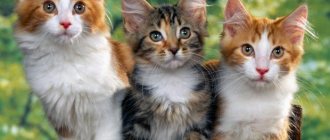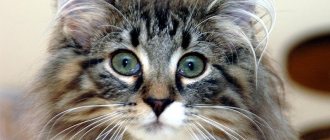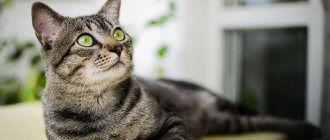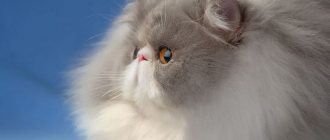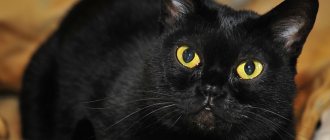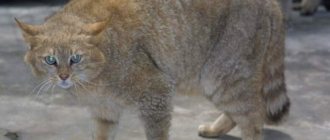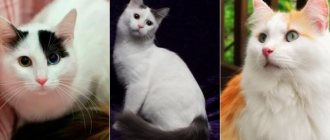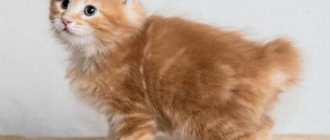The hearts of many cat lovers were won by a long-haired representative of the British breed, with a gentle look, remarkable appearance and calm character. The British Longhair cat did not immediately receive official recognition. First-born hybrid kittens disappointed breeders.
Cute creatures originally from Great Britain appeared in the 20th century through experimental crossing of short-haired British women with fluffy Persians. But, there were a few cute long-haired kittens left, which became the progenitors of the current representatives. A little later this breed was recognized as a separate breed. Today, British Longhair kittens are popular not only in their historical homeland, but also in other countries of the world.
History of British Longhair cats
The past of the Lowlanders cannot be called ancient, much less glorious.
The breed arose due to a recessive gene for long hair, the carriers of which, according to felinologists, should not have been allowed to reproduce. Moreover, the breeders themselves were to blame for the genetic failure; in the mid-50s they wanted to expand the color palette of British shorthairs by crossing them with Persians. At first, everything went according to plan: kittens born from mixed “marriages” inherited the luxurious colors of Persian cats and the short hair of their English parents. However, after several generations, the “increased fluffiness gene” made itself felt, and the animals began to bear long-haired offspring. Breeders were not prepared for such a surprise, so at first they strictly rejected fluffy kittens, selling them for a symbolic price, or even for free, provided that no one would breed such pets.
Soon, the longhaired variation of the British found a few fans who began to “push” the breed into the TICA and WCF breeding lists. But since the British cats were distinguished from their English ancestors only by their voluminous fur coats and nothing more, some felinological clubs in Europe and the USA continued to register them as a variety of British cats. At the same time, TICA recognizes Lowlanders, although for now in the status of a new breed.
Important: today, crossing Persians with British shorthair and longhair cats is prohibited.
At the same time, matings between Lowlanders and traditional British are allowed by some clubs.
Family history
The breed first appeared in the 20th century. The furry result was the crossing of British Shorthair cats with Persian and Somali cats.
The English felinologists initially wanted to improve the British, but the results exceeded all expectations! So, today this breed has been assigned a personal standard, and it is recognized at the official level.
Many representatives of the breed confidently take first places at professional exhibitions.
Just look at the photo of the British Longhair, she really is worthy of all praise, her grace alone is worth it!
There are other names for the breed: Britannica or Highlander (European countries); Lowlander (USA and Netherlands).
British Longhair breed standard
At first glance, the longhaired variation is distinguished from its British shorthaired cousins only by its more striking “outfit.” Moreover, if you take a closer look, it becomes clear that this is a rare case when the first impression is not deceptive. Perhaps this is why TICA did not begin to draw up a separate standard for the breed, but simply slightly modified and adjusted the existing version intended for British Shorthairs.
Head
The British Longhair is a medium to large sized cat with a round, cheeky face. The animal's chin is voluminous, the bridge of the nose is flat, short, and practically without a stop. The vibrissae of representatives of the breed are clearly marked, convex, rounded in shape.
Eyes
The large, round eyes are moderately wide apart, and the color of the iris matches the color of the coat. The exception is silver-colored individuals, for whom a rich green iris tone is preferred.
Neck
The thick, muscular, short neck extends into round cheeks. In mature cats and cats, this part of the body expands in width, so it seems that there is no neck as such.
Ears
The ears of the British Longhair are small to medium in size, set on the sides of the rounded cat's skull without becoming splayed out. The base of the ear is wide, the tip is moderately rounded.
Body
The body of the British Longhair cat is powerful, wide, and smoothly rounded in outline. The chest is also massive. The back is straight, the sides look voluminous.
Limbs
The legs of representatives of the breed are of moderate length, strong and strong. The paws are thick and large. The animal itself looks squat, but not short.
Tail
Both shorthaired and longhaired Britons boast thick, medium-length tails with an elegantly rounded tip.
Color
The purebred Lowlander has the same colors as its shorthaired cousin, that is, solid, tortoiseshell, smoke, tabby, bicolor.
Wool
The coat is semi-long type. The hair is dense, elastic, not tight. It is desirable to have a richly pubescent collar area and panties. But the pronounced wooliness of the coat, as well as thin long hair with a hint of the airiness inherent in Persians, are rejected.
Disqualifying faults
Disqualifying defects mean defects in behavior and appearance that call into question the breed of the animal. These in British longhair cats include: jaw distortion, skin pigmented in tones that do not match the overall color, incorrect eye color, as well as an unreasonably aggressive reaction in response to the action of exhibition specialists. Poor physical shape, as well as severe pain, are also considered sufficient reasons to deny a pet and its owner entry into the ring.
Appearance
Externally, these are massive animals, with a dense body, strong limbs, and a short tail. The coat is medium length and has many color variations.
Head
The British have a round, massive skull with a powerful chin, straight nose and plump cheeks. The full pads of the mustache stand out very well. The eyes are large, usually the color matches the color of the coat.
Weight
On average, the weight of a longhaired British cat is 3-5 kg, and that of a male cat is 5-7 kg.
Frame
Have a stocky build. The shoulders, chest and back are quite wide, and the paws are round in shape and quite strong in appearance.
Color
This breed has many coat colors. The main ones:
- smoky - a very beautiful ash or dark gray color;
- tabby or tabby - a spotted, striped or marbled cat, can be of any color;
- tortoiseshell - can be in a combination of multi-colored spots of cream and blue; black and red.
Very handsome British man
Personality of the British Longhair cat
The longhaired British cat is the embodiment of delicacy and peacefulness itself. Actually, for these character traits alone, representatives of the breed can be recommended to owners who want to have a problem-free pet next to them, to whose whims they do not have to adapt. Lowlanders are extremely moderate in their preferences and do not cross the line beyond which misunderstandings and friction with the owner begin. For example, furry intellectuals adore human company, but in his absence they do not fall into depression, preferring to quietly philosophize on their favorite couch or armchair. By the way, breeders who have many years of experience in breeding the breed claim that the character of their charges is more docile and good-natured than that of short-haired British cats.
Kittens also experience attacks of mild melancholy, during which they are reluctant to contact the owner and members of his family. During such periods, it is better not to pester your pet, giving him the opportunity to take a slight break from communication - don’t worry, this withdrawal will not last long. Morning oratorios while waiting for breakfast are also not about the British. From time to time, English “gentlemen” are able to remind themselves with a quiet, slightly rolling “meow”, but they certainly will not scream to attract attention or in confusion of feelings.
But the long-haired Briton will not refuse to play, and this comrade perceives with equal delight both entertainment in the company of a person and the independent “torment” of a wind-up mouse or ball. As they grow up, British Longhairs become more phlegmatic and slow down in terms of physical activity, so anyone who is scared of hurricane cats, dashingly diving from the closet to the sofa and overturning flower pots of any weight, can get such a pet.
Purrs treat children patiently and condescendingly, provided that the latter do not annoy the animal too much with their attention. When bringing a British Longhair cat into your home, inform your children that the breed does not like strong hugs, nor does it like a noisy, nervous environment. We are ready to tolerate lowlanders and the presence of dogs. True, in order for the relationship between the dog and the representative of the purring brethren to become extremely peaceful, it is better that acquaintance and getting used to each other take place at a young age.
Character and behavior
Combining the blood of a proud British woman and a swaggering Persian, the Highlander ended up with a wonderful character - friendly and sociable, but at the same time calm and unobtrusive.
Positive and negative qualities, preferences
Owners of British Longhairs consider their pets ideal, but you and I know that this does not happen - and this breed also has both advantages and disadvantages.
Pros and cons of the British Longhair breed
| Advantages of the breed | Disadvantages of the breed |
|
|
Relationships with people
The owner and his activities are always interesting to this cat - she is ready to accompany her main person everywhere and watch him. Family, good relationships between household members, peace and comfort are very important for the British Longhair; in critical situations, she often takes on the role of peacemaker. She is patient with young children who are too active, but will not tolerate familiarity from strangers, although she behaves evenly and hospitably with everyone who comes into the house.
Cats of this breed are very attached to their owners.
Get along with other pets
British people are absolutely non-confrontational, and in case of misunderstandings in a large company they often act as peacemakers. They get along well with other cats, and even with dogs, but on one condition - no one should encroach on their rights and territory. But it is better not to leave birds and small rodents alone with these cats - the hunting instinct, which is very strong in them, may suddenly come into play.
Education and training
The British are not the most energetic breed, so it is not advisable to practice circus acts with them in the “we are from the Kuklachev Theater” style. But it is necessary to correct the cat’s behavior by instilling in him the norms of household etiquette. Moreover, after a year, lowlanders lose their thirst for knowledge and stubbornly refuse to re-educate.
At first, special literature will help out - the books “Raising Kittens” by E. Filippova, “Bad Habits of Cats. Parenting without stress” by A. Krasichkova and others. If the kitten came from a breeder who did not bother to instill in him toilet skills, get ready to take on this work yourself. Fortunately, British Longhairs are naturally clean and quickly realize that it is much more pleasant to do “wet things” in a pile of dry litter than on a slippery floor.
Be sure to take into account the subtle mental organization of the breed - British breeds tend to keep silent and absorb grievances, which negatively affects their psyche. So if at first the cat makes mistakes and goes to the toilet in the wrong place, it is better to close your eyes to the odorous “pools” and try alternative methods of litter training - put a cloth in the box that smells of cat urine, or rustle the litter in the presence of the kitten. And, please, no grandma’s methods that involve poking the baby’s nose into a puddle - no matter what home-grown experts in cat psychology say, such educational moments do nothing but harm. Remember, the kitten is not able to endure for long and often forgets which room its toilet is in, so at first it is recommended to place a couple of trays in the house to avoid “wet incidents”.
British longhair cats are greedy for positive incentives, so for any achievement, praise your ward from the bottom of your heart. True, here it is important to distinguish between actual achievements and norms of behavior. If for once the cat ignored the sofa and did not sharpen its claws on its back, this is not a reason to rush for a tasty reward for it.
It is better to keep punishments to a minimum, but if the purr begins to become impudent and encroach on the forbidden, the prankster will have to be put down. The best method of influence is considered to be intonation highlighting. If you categorically and firmly say “No!” the cat sitting on the table, at the same time tapping his palm on the tabletop, he will understand this. Don’t even consider spanking your pet with newspapers, your hand, or a slipper that has turned up - you can’t hit any cat, let alone an intelligent and impressionable British Longhair.
Choosing a kitten
The main selection criterion is the further purpose of use. For fun, take a pet aged 3 months and older. But older cats are litter box trained, feed themselves and have been vaccinated against potential diseases.
An examination will help you make a choice and look at the character of the animal. For breeding offspring and participation in exhibitions, cats are taken after 6-7 months. Until this age, anomalies do not appear and it is difficult to determine class affiliation.
Under no circumstances should you choose a kitten on the street or near shops or markets. No self-respecting breeder will bring a purebred pet into a public place. It is optimal to choose a good, certified nursery, but in this case the price of a pet can significantly exceed that of private breeders.
When choosing a nursery, you should pay attention to the following details:
- everything that concerns the cat must be clean: trays, bowls, beds;
- there should be no smell of urine;
- the house should have complexes such as houses, scratching posts, toys;
- A reputable breeder must show a certificate from the nursery and the pedigree of the parents.
The best option is to have no more than 1-3 adult pets in the house. The breeder must be competent, friendly and sociable, and know a lot about the breed.
Kittens:
- curious, playful, healthy, active;
- well-groomed;
- accustomed to human hands.
The latter means that they should not hiss or show aggression. But the British don't like to be held, so a struggling baby isn't necessarily a deviation from the standard. He must be willing to make contact, play, and not hide in the corners.
Parents should also be well-groomed; if one of them is missing, you can ask for his photo or look at exhibitions. Signs of a healthy kitten:
- nose - wet, cold;
- eyes - clear, shiny, transparent discharge is allowed (a feature of the breed)
- ears - clean, without black spots;
- tail - check for any kinks;
- teeth - white, even, normally located;
- wool - without bald spots, wounds, etc.
Maintenance and care
Toys, a sisal scratching post, a bed, bowls for food and drink - property that any cat owner should have. It is important to promptly change the litter in the toilet of a British longhair cat. Representatives of this family are demanding cleanliness and will never go into a tray with the products of their own vital activity. If desired, you can buy a gaming set for your pet, and it doesn’t have to be a high one - the breed does not suffer from a mania for conquering peaks. At least once a day, it is advisable to take your cat outside to get some fresh air, or set up a corner on a net-covered balcony where she can replenish her stock of impressions.
Hygiene
The elastic, lagging hair of the British Longhair differs from the hair of Persian cats, so it does not tangle as easily and does not become tangled. However, you will have to brush your pet at least once a week. Individuals who permanently live in the house shed not seasonally, but throughout the year, so if you notice that your cat’s fur is shedding more intensely than usual, it is better to increase the frequency of brushing.
The eyes of British Longhairs are sensitive and may leak, which is especially noticeable in kittens. There is no need to make a tragedy out of this phenomenon, just remove the mucous lumps with a clean cotton swab dipped in phytolotion, not forgetting to monitor the intensity of the discharge. If your eyes are leaking too much, this is not a reason to grab strong anti-inflammatory drops without consulting a specialist, since there is a risk of worsening the situation.
Lowlanders' claws, like their short-haired relatives, grow unevenly. Breeders recommend shortening the claws on the front paws once every 2-3 weeks, and on the hind paws no more than once a month. It is necessary to clean your ears as they become dirty, without falling into perfectionism. That is, if a cat has secreted a large amount of secretion, it is removed with a cotton pad soaked in hygiene lotion or hydrogen peroxide. If there is little sulfur, it is better to close your eyes to its presence, since the more often the ear is cleaned, the more intensely the excretory glands work.
If your pet does not eat dry food, which acts as an abrasive for teeth, be prepared to systematically clean its oral cavity with a zoopaste and a brush. The British Longhairs themselves do not respect such actions, so it is often necessary to involve a second person for processing, and sometimes to “swaddle” the animal so that it does not interfere with the process of neutralizing food plaque.
An alternative to classic brushing is a liquid toothbrush. This is the name for special solutions added to drinking water and performing the function of a disinfectant and plaque dissolving agent. In particularly advanced cases, when your pet has acquired tartar, you will have to contact a veterinarian. But since in zoos such procedures are often carried out under anesthesia, it is better not to neglect regular home cleaning.
Feeding
There are no strict instructions requiring that a British Longhair cat be fed only dry or natural food, so each breeder chooses his own ideal option. The main advantage of industrial feeds over natural products is their balance and availability. A purr “sitting” on dry food does not need additional vitamins, however, provided that it is food of at least super-premium class.
The natural menu of longhaired British cats traditionally includes:
- turkey, lamb, beef and chicken meat, heat-treated or frozen;
- boiled offal;
- fermented milk products and milk (only for kittens);
- quail eggs.
It is better to give fish less often and in the form of boiled fillets, since some types contain substances harmful to the cat’s body. Cereals (buckwheat, rice) are mixed with meat in limited quantities. Do the same with boiled and raw vegetables - pumpkin, carrots, zucchini. Quail eggs can be replaced with chicken yolk. You can also cook an omelet with it.
For up to six months, milk is present in the diet of British Longhair kittens, but then its consumption should stop - the body of an adult animal does not produce enzymes that break down milk protein. Be sure to grow it on the windowsill or buy young grass for the cat - with its help the animal gets rid of hairballs that got into the stomach when licking the body.
It is useful to periodically feed cats on a natural diet with vitamins and complexes with taurine, but it is better if they are prescribed by a veterinarian after an examination. Some breeders introduce homemade dietary supplements into the diet, such as rosehip and nettle infusions, although they are not always able to cover the pet’s need for microelements and vitamins. Three-month-old British cats are fed up to four times a day; six-month-old individuals are transferred to a two- or three-time diet.
Standard according to WCF version
Just a few years ago, the Scottish Fold Highland Fold was a rare occurrence in litters when two Scottish Shorthairs were mated. Now, many breeders are engaged in their breeding, who strive to preserve it.
Upon external examination, the presence of Persian blood becomes obvious - the eyes are close-set, the profile is smoothed, the coat is very soft.
According to the WCF standard, the Scottish Highland Fold must have a proportional body that is rounded and ends in a long tail.
It is very important that the tail is flexible, otherwise it will be considered a defect.
Their paws are round and their head is rounded. One of the distinctive features is the strong-willed chin and shortened nose.
The eyes are large and widely spaced. The Scottish Fold has a very dense and long coat that comes in different shades. Over time, it may become a little weak, but this should not be allowed, since according to the standard this will already be a drawback, albeit a small one.
Ears are pressed tightly to the head and directed downwards. They have several folds that make them stand out from other breeds. The number of folds affects the degree of curvature of the ear. So, in the third degree, the ear is pressed tightly.
The resulting estimates largely depend on the quantity and quality of such folds, because they are one of the indicators of this type. This breed can get the maximum number of points for its ears and tail. Therefore, you must carefully examine the kitten before picking it up from the breeder. In this case, the ears and tail are especially carefully checked.
Determination of purebredness occurs already in the third week after birth, when the kittens’ ears begin to curl.
A cat whose tail is found to have a hook on it or whose tail is too short and inactive will be disqualified. Also, abnormal bone changes and an unusual number of toes are not allowed. And the presence of diseases can often be one of the main reasons for the disqualification of a Highland
That is why it is important to carefully monitor his condition and feed him adequately.
Be careful even at the stage of choosing a kitten, because a thorough examination will allow you to choose a baby with good health and prevent many problems in the future. If you are a beginner and are not very well versed in all the features, then it is advisable to consult with a more experienced breeder in advance or read the relevant literature.
Health and disease of British Longhair cats
Longhaired British cats live up to 18-20 years. They have few health problems, but given the developing status of the breed, it is logical to assume that some of the ailments may manifest themselves over time. In the meantime, diseases such as hypertrophic cardiomyopathy and polycystic kidney disease cause discomfort to cats. As for obesity, to which diligently fed individuals are prone, it is easier to combat it in the early stages. Neglected fat cats manage to accumulate a sufficient number of serious ailments, including arthritis, diabetes and hepatic lipidosis.
Interesting facts about the origin of Highland Straights
The previous generation of Scottish Highland Straights were wild cats. These animals were hunted in the high mountains of Scotland in the 18th century. It’s hard to believe, but it was these predators who became the parents of beautiful and gentle Highland Straights.
The first exhibition of the pointy-eared longhaired Scots took place only in the 70s of the 20th century, when their relatives - the Highland Folds - were already showing off with might and main at cat shows in the early 19th century. And all because straight-eared Scottish dogs were then considered defective.
Beautiful cat of the Highland Straight breed
Official confirmation of the breed might not have happened if the scientists involved in breeding new breeds did not want to conduct a series of experiments during which it was planned to improve the fluffy Scottish. The first crossing of a Scotsman occurred with a Persian cat, then with a British one. The result of the experiment was amazing. Thanks to this relationship, a large number of colors were obtained.
After some time, the Highland Scottish Straight and Highland Scottish Fold breeds were developed. Their main difference is the shape of the ears. In the former they are straight and sharp, in the latter they are inclined towards the head (loop ears).
Highland straight
Scots with long hair were officially recognized in the late 90s of the 20th century. Since that time, Scottish cats with straight ears have been honored guests at cat shows.
Highland straights are a very rare breed with their own characteristics. They are unpretentious, do not require special care and do not require feeding with elite food. They do not tolerate noise, scandals, quarrels, a dirty tray, or an unwashed food bowl. If you follow all the recommendations for caring for your pet and proper nutrition, your pet will please its owner for 20 long years.
How to choose a kitten
- As the breed continues to gain popularity, buyers will encounter unscrupulous sellers selling problem animals. In order to purchase a kitten, it is better to go to breed exhibitions where professionals gather.
- Fans of more playful pets are advised to opt for a male kitten. Long-haired “British girls” are calmer and more phlegmatic than males.
- Look for a nursery registered in the WCF felinological system - such institutions value their reputation and do not breed animals without pedigrees. In addition, the websites of most of them contain photos and documents of the producers, from which you can get a relative idea of the appearance of future litters.
- British Longhair kittens are sold starting from the age of three months. If the breeder offers to give the baby away earlier, there is a catch.
- In three-month-old kittens, the exterior potential is practically not visible, so for exhibitions it is better to take older individuals (4-6 months), whose iris color has been determined and the first moult has passed.
- Assess the living conditions of the cat and its offspring. The nursery should be clean and warm, and the animals should look healthy and well-groomed.
- Browse advertisements for the sale of child support children. They are given by cat owners who receive a kitten as payment for mating their ward with a cat from the nursery. Buying such kittens is quite acceptable, especially since the maintenance animal is given away first, and is usually the cutest kitten in the litter. The main thing is to check the purity of the parents’ pedigrees.
Choosing a kitten and its price
The longhaired British breed has many fans, so getting a kitten will not be a problem. Please note that the price of a cat is always cheaper than a cat. Also, the cost will depend on the color, purity of the pedigree (presence of Persians), and the status of the nursery. Kittens with appropriate documentation are more expensive.
There is a division into classes: show, breed and pet. Exhibition representatives are more expensive than usual, their price starts from 15,000 rubles. An ordinary kitten for home can be found through private advertisements from 3,000 rubles. Be careful when choosing and beware of scammers. Look at the parents and the rest of the kittens. Make sure you are paying for a British Longhair and not just a fluffy kitten.
Advantages and disadvantages
The positive aspects of the British Longhair include:
- agreeableness;
- intelligence;
- beauty;
- no need for increased attention;
- ease of care;
- devotion;
- patience.
Minuses:
- self-sufficiency;
- poor handling;
- excessive love of solitude;
- unsociability.
